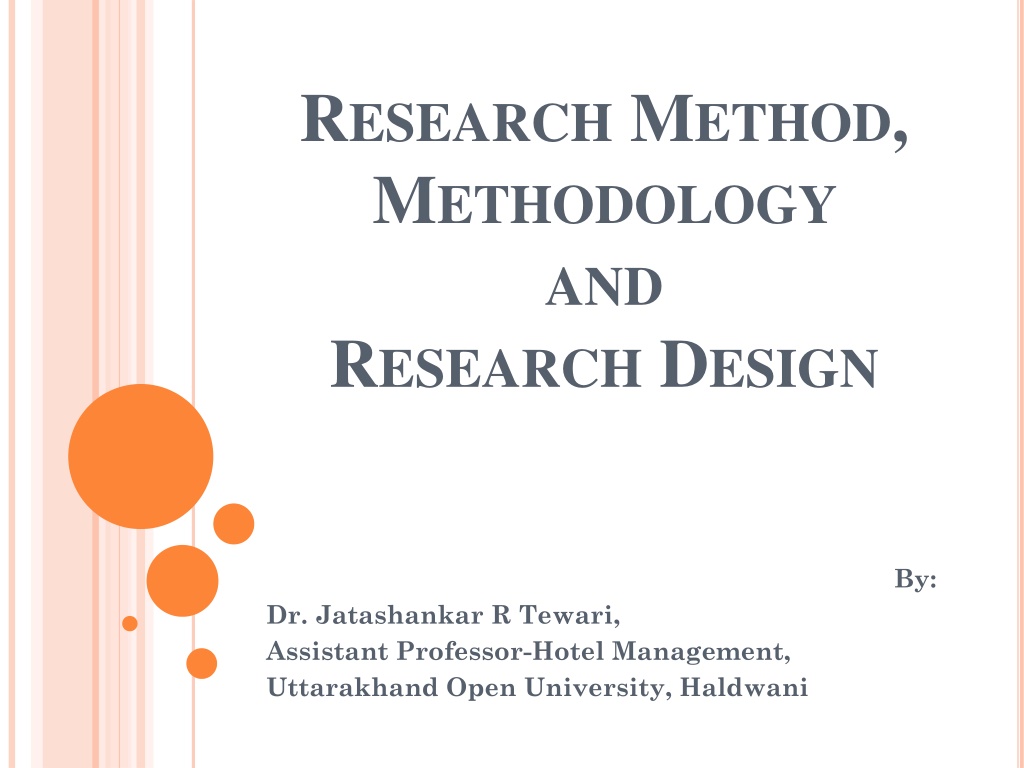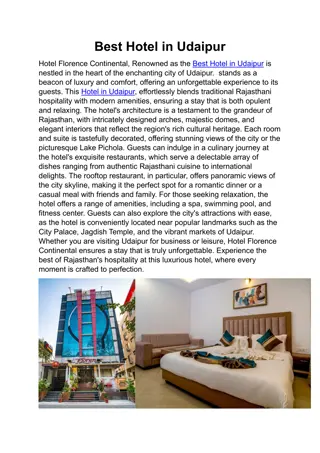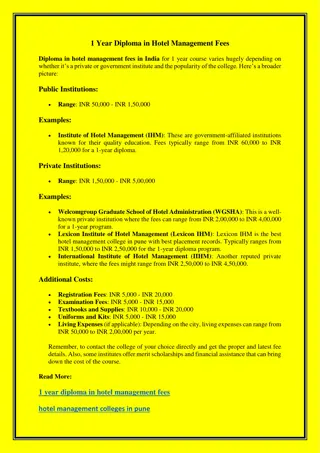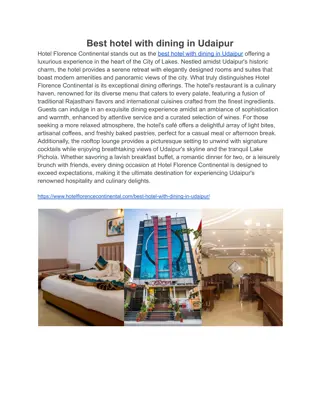Understanding Research Methods and Methodology in Hotel Management
Research in hotel management involves a structured process of inquiry to collect, analyze, and present information on various topics. The research process typically consists of steps like posing a question, collecting data, and presenting answers. Researchers follow a scientific method to identify problems, make predictions, gather relevant data, and analyze it to support their predictions. Quantitative research methods play a key role in testing objective theories by examining relationships among variables through statistical analysis. The process of research includes six essential steps, such as identifying a research problem, reviewing literature, specifying research purposes, collecting and analyzing data, and reporting findings.
Download Presentation

Please find below an Image/Link to download the presentation.
The content on the website is provided AS IS for your information and personal use only. It may not be sold, licensed, or shared on other websites without obtaining consent from the author. Download presentation by click this link. If you encounter any issues during the download, it is possible that the publisher has removed the file from their server.
E N D
Presentation Transcript
RESEARCH METHOD, METHODOLOGY AND RESEARCH DESIGN By: Dr. Jatashankar R Tewari, Assistant Professor-Hotel Management, Uttarakhand Open University, Haldwani
RESEARCH What is Research? Research is a process of steps used to collect and analyze information understanding of a topic or issue . to increase our At a general level, research consists of three steps: 1. Pose a question 2. Collect data to answer the question 3. Present an answer to the question
THE SIX STEPS IN THE PROCESS OF RESEARCH When researchers conduct a study, they proceed through a distinct set of steps. Years ago these steps were identified as the scientific method of inquiry (Kerlinger, 1972; Leedy & Ormrod, 2001). Using a scientific method, researchers: Identify a problem that defines the goal of research Make a prediction that, if confirmed, resolves the problem Gather data relevant to this prediction Analyze and interpret the data to see if it supports the prediction and resolves initiated the research the question that
The process of research consists of six steps: 1. Identifying a research problem 2. Reviewing the literature 3. Specifying a purpose for research 4. Collecting data 5. Analysing and interpreting the data 6. Reporting and evaluating research
QUANTITATIVE RESEARCH METHODS Quantitative Research is an approach for testing objective theories by examining the relationship among variables. These variables, in turn, can be measured, typically on instruments, so that numbered data can be analysed using statistical procedures. The final written report has a set structure consisting of introduction, literature and theory, methods, results, and discussion. The researcher in this form of inquiry have assumptions about testing theories deductively, building in protections against bias, controlling for alternative explanations, and being able to generalize and replicate the findings.
QUANTITATIVE RESEARCH HARACTERISTICS The major characteristics of quantitative research are: Describing a research problem through a description of trends or a need for an explanation of the relationship among variables Providing a major role for the literature through suggesting the research questions to be asked and justifying the research problem and direction(purpose statement and research questions or hypotheses) of the study Creating purpose statements, hypotheses that are specific, narrow, measurable, and observable Collecting numeric data from a large number of people using instruments with preset questions and responses Analyzing trends, comparing groups, or relating variables using statistical analysis, and interpreting results by comparing them with prior predictions and past research Writing the research report using standard, fi xed structures and evaluation criteria, and taking an objective, unbiased approach creating a need for the research questions, and
QUALITATIVE RESEARCH METHOD Qualitative Research is an approach for exploring and understanding the meaning individuals or groups ascribe to a social or human problem. The process of research involves emerging questions and procedures, data typically participant s setting, data building from particulars to general themes. The researcher making interpretations of the meaning of the data. The final written report has a flexible structure. The researcher in this form of inquiry support a way of looking at research that honors an inductive style, a focus on individual meaning, and the importance of rendering the complexity of a situation. collected analysis in the inductively
QUALITATIVE RESEARCH CHARACTERISTICS In qualitative research, characteristics at each stage of the research process: Exploring a problem and developing a detailed understanding of a central phenomenon Having the literature review play a minor role but justify the problem Stating the purpose and research questions in a general and broad way so as to the participants experiences Collecting data based on words from a small number of individuals so that the participants views are obtained Analyzing the data for description and themes using text analysis and interpreting the larger meaning of the findings Writing the report using flexible, emerging structures and evaluative criteria, and including the researchers subjective reflexivity and bias we see different major
MIXED METHODS RESEARCH Mixed Methods Research is an approach to inquiry involving collecting both qualitative data, integrating the two forms of data, and using distinct designs that may involve philosophical assumptions frameworks. The core assumption of this form of inquiry is that the combination of qualitative and quantitative approaches provides understanding of a research problem than either approach alone. quantitative and and theoretical a more complete
WHAT IS A RESEARCH DESIGN? A research design is a plan, structure and strategy of investigation so conceived as to obtain answers to research questions or problems. It includes an outline of what the investigator will do from writing the operational implications to the final analysis of data. (Kerlinger, 1986) According to Selltiz, Deutsch and Cook(1962), A research design is the arrangement of conditions for collection and analysis of data in a manner that aims to combine relevance to the research purpose with economy in procedure . Research designs are the specific procedures involved in the research process: data collection, data analysis, and report writing. hypotheses and their
RESEARCH DESIGNS ASSOCIATED WITH QUANTITATIVE AND QUALITATIVE RESEARCH
QUANTITATIVE RESEARCH DESIGNS Experimental researchers seek to test whether an educational practice or idea makes individuals. Experimental research procedures are ideally suited for this study. Experimental designs (also called intervention studies or group comparison studies) quantitative research in which the investigator determines whether an activity or materials make a difference in results for participants. You assess this impact by giving one group one set of activities (called an withholding the set from another group. Designs: Some quantitative a difference for are procedures in intervention) and
Correlational Designs: In some studies, you may be unable to provide an intervention or to assign individuals to groups. Moreover, you focus more on examining the association or relation of one or more variables than in testing the impact of activities or materials. Correlational designs are procedures in quantitative research in which investigators measure the degree of association (or relation) between two or more variables using the statistical procedure of correlational analysis. This degree of association, number, indicates whether the two variables are related or whether one can predict another. To accomplish this, you study a single group of individuals rather than two or more groups as in an experiment. expressed as a
Survey quantitative research, you may not want to test an activity or materials or may not be interested in the variables. Instead, you trends in a large population of individuals. In this case, a survey is a good procedure to use. Survey designs are procedures in quantitative research in which you administer a survey or questionnaire to a small group of people (called the sample) to identify trends in attitudes, opinions, characteristics of people(called the population). Designs: In another form of association seek among describe to behaviors, large or of a group
QUALITATIVE DESIGNS Grounded Theory Designs: Instead of studying a single group, you might examine a number of individuals who have all experienced an action, interaction, or process. Grounded theory designs are systematic, qualitative procedures that researchers use to generate a general explanation (grounded in the views of participants, called a grounded theory) that explains a process, action, or interaction among people. The procedures for developing this theory include primarily collecting developing and relating categories (or themes) of information, and composing a figure or visual model that portrays the general explanation. In this way, the explanation is grounded in the data from participants. From this explanation, you construct predictive statements about individuals. interview data, the experiences of
Ethnographic Designs: You may be interested in studying one group of individuals, in examining them in the setting where they live and work, and in developing a portrait of how they interact. An ethnographic study is well suited for this purpose. Ethnographic designs are qualitative procedures for describing, interpreting a cultural group s shared patterns of behavior, beliefs, and language that develop over time. In ethnography, the researcher provides a detailed picture of the culture-sharing group, drawing on various sources of information. The ethnographer also describes the group within its setting, explores themes or issues that develop over time as the group interacts, and details a portrait of the group. analyzing, and
Narrative Research Designs: You may not be interested in describing and interpreting group behavior or ideas, explanation grounded in the experiences of many individuals. Instead, you wish to tell the stories of one or two individuals. Narrative research designs are qualitative procedures in which researchers describe the lives of individuals, collect and tell stories about these individuals lives, and write narratives experiences. In education, these stories often relate to school classroom activities in schools. or in developing an about their experiences or
MIXED METHOD DESIGNS Mixed Methods Designs: You decide to collect both quantitative data (i.e., qualitative data (i.e., text or images). The core argument for a mixed methods design is that the combination of both forms of data provides a better understanding of a research problem than either quantitative or qualitative data by itself. Mixed methods designs are procedures analyzing, and mixing qualitative data in a single study or in a multiphase series of studies. In this process, you need to decide on the emphasis you will give to each form of data (priority), which form of data you will collect fi rst (concurrent or sequential), how you will mix the data (integrating or connecting), and whether you will use theory to guide the study (e.g., advocacy or social science theory). quantifiable data) and for collecting, both quantitative and
Action Research Designs: Like mixed methods research, action research designs often utilize both quantitative and qualitative data, but they focus more on procedures useful in addressing practical problems. Action research designs are systematic procedures used by researcher to gather quantitative and address the problems. In case of educational research, they are focused on improvements in their educational setting, their teaching, and the learning of their students. research designs, you seek to address and solve local, practical problems, such as a classroom- discipline issue for a teacher. In other studies, your objective might be to empower, transform, and emancipate individuals settings. qualitative data to In some action in educational























